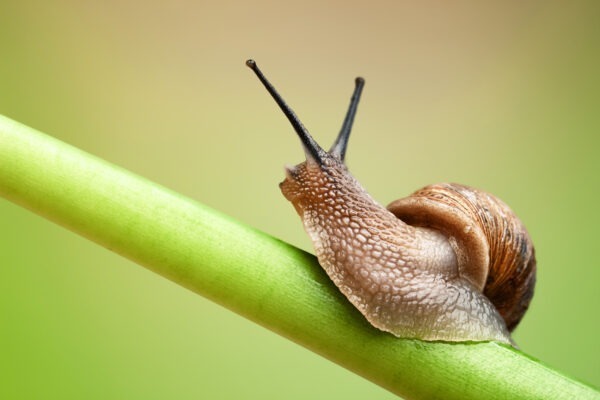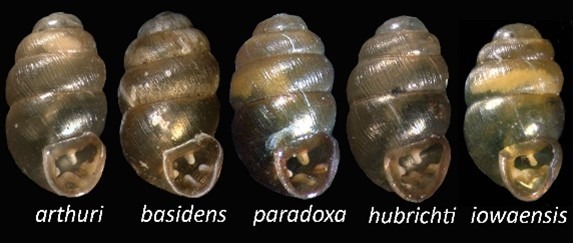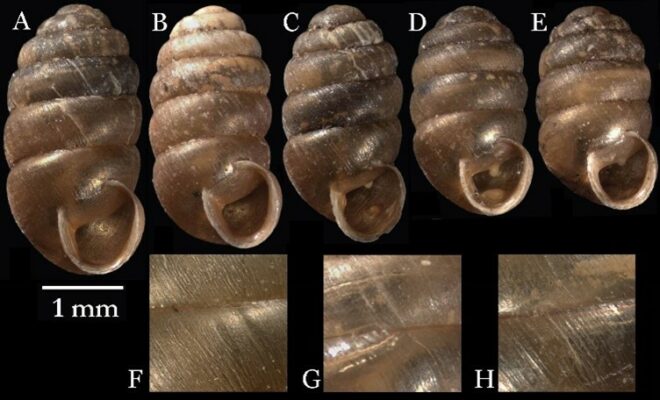
A Customer Success Story
Correctly Identifying Land Snail Species Using Omega Bio-tek’s E.Z.N.A.® Mollusc DNA Kit
Dr. Jeff Nekola and his land snail biodiversity research group work out of Masaryk University in the Czech Republic. Dr. Nekola, classically trained in plant community ecology, felt early on in his career that he was only seeing a sliver of the patterns influencing biodiversity. It was essential to expand into less studied phyla with high species diversity. He states, “Land snails offered a unique opportunity given that they are essentially sessile (like plants), have a mature taxonomy with the majority of species having been described, and can be identified to species using shells (which can be sampled year-round).”
Throughout his career, Dr. Nekola has observed thousands of sites across North America and encountered over half of the 1200 species of North American land snails to document the current and historical factors which have impacted their biodiversity. But, to do this accurately, biologically valid species concepts must be known. And for the overwhelming majority of land snails, the species-level classification remains rooted in the judgment of a given taxonomic expert rather than on replicable, empirical scientific data. As a result, psychological factors can easily make conventional taxonomic wisdom inaccurate.
To ground his biodiversity analyses more firmly in biological reality, he needed an independent assessment of the validity of the species he was analyzing. Since no one had yet conducted this work, he realized he would have to, and he stated, “roll up my sleeves and do it myself.”


Thus, he started assessing species using molecular methods and techniques (for instance, Nekola et al., 2015, 2018 and Horsáková et al., 2019). “Our first project was funded by the Minnesota Department of Natural Resources to assess the validity of five endangered species that were thought to represent Ice Age relicts restricted to ice cave entrances. But, when you looked at their DNA, none of them were biologically valid. Rather, they represented different shell forms of a single species that ranged from Newfoundland and Labrador to Alaska and down the Rockies to New Mexico. All these supposed local endemics represented unwarranted exuberance from the local taxonomist who wanted there to be something unique and special living in these rare habitats. We were able to show this to the Minnesota DNR and help them target other valid species that deserved conservation.”
Difficulties with Mollusc DNA Extraction for Traditional PCR and NextGen Applications
Extracting clean mollusc DNA is notoriously challenging. Mollusc secretions contain elevated levels of polysaccharides and mucus, which interfere with downstream applications such as Polymerase Chain Reaction (PCR) or Next Generation Sequencing (NGS). Dr. Nekola’s team started by using another company’s standard extraction kit. His group quickly discovered that while DNA was present, high inhibition factors caused DNA amplification to fail within 48 hours of extraction for samples held at 4 °C and within two weeks, even at -80 °C. After nine months of trial and error, they found a workaround, but it proved to be “convoluted and messy.”
When Dr. Nekola picked up the pipettors again two years later, one of his colleagues in Michigan recommended Omega Bio-tek’s E.Z.N.A.® Mollusc DNA Kit. According to Dr. Nekola, “we gave it a try, and I’ve never had any trouble since.” He continues, “now when I extract molluscan DNA, it’s stable, it’s clean, and keeps amplifying after even a decade in storage. If it wasn’t for the E.Z.N.A kit, there is no way I would have continued with molecular verification of species taxonomy. It was just too hard to get clean DNA that would amplify and provide us with the data we needed. So, I thank you guys so much for putting that kit together because otherwise, all the work I have done since 2009 would have been impossible. Literally.”
Dr. Nekola’s laboratory also uses Omega Bio-tek’s E.Z.N.A.® Mollusc DNA Kit for extractions used in NGS platforms such as Illumina®. Here too, he has found this vital in ensuring valuable results. Recently they ran into similar setbacks involving inhibition factors when “we sent some specimens off to a NextGen genomic laboratory in Germany. They chose to use another company’s extraction kit, and the data they generated was basically worthless. We made them extract a second set of samples using your [E.Z.N.A.® Mollusc DNA] extraction kit, and this time they were able to generate useful data. It is clear that the E.Z.N.A. kit is just as important for successful genomics applications as it is for standard PCR.”
He continues, “I’ve gotten to the point where I just tell people, ‘If you want to extract molluscan DNA, go, and buy the Omega Bio-tek kit because you are not going to be happy with your results otherwise.’”
How Omega Bio-tek’s E.Z.N.A.® Mollusc DNA Kit Has Improved Our Understanding of Land Snail Biodiversity and Climate Modeling
The E.Z.N.A.® Mollusc DNA Kit has enabled Dr. Nekola’s team to pursue groundbreaking work. Subsequent analyses across the Holarctic (Nekola & Horsák, 2022) has demonstrated that less than 50% of recognized land snail species in the region were both biologically valid and identified using reliable characters: 25% of all species had incorrect features being used for identification, while another 25% were not valid and represented shell forms of previously described species. A third (1/3) of the species with incorrect ID features illustrated multiple valid species that had been incorrectly lumped together. Because of this, Nekola realized that “all the species I am working with ultimately need to be independently verified using molecular data. We have expanded our DNA surveys to include over one-third of all boreal and arctic land snail taxa, ranging from Scandinavia to Siberia, Alaska to Newfoundland and Labrador, the Bering Strait, and Baffin Island in eastern Canada. We continue to find high rates of error in traditional taxonomic concepts – both in terms of identification features and invalid concepts – and new species that had been hidden in plain sight within other taxa.”


Dr. Nekola says that without the E.Z.N.A.® Mollusc DNA Kit, “I would’ve given up molecular verification of species concepts. If I had done that, less than half of the species I study would have been correct. This would have led to almost 40% of my site species lists being in error. I would have underestimated the actual rate of change in species composition across space, with traditional, unvetted taxonomic concepts leading to an overestimation of turnover at short distances but an underestimation at long distances. Accurate documentation of biodiversity patterns requires that species concepts be independently validated using molecular data. In the group I study, this means using the E.Z.N.A. extraction kit.”
A recent example bears this out. Dr. Nekola explains, “My colleague, Michal Horsák, went to Iceland this last summer to do fieldwork associated with a grant-funded project of ours. He saw a land snail on dry grasslands that looked identical to one from continental Europe, which was restricted to wetlands. Thanks to the E.Z.N.A. extraction kit and subsequent DNA sequence analysis, upon his return, we were able to rapidly prove that these populations were, in fact, the same species.” The shifting of this species from wetland to dry grassland habitats in areas with limited maximum summer temperature helps explain why its Ice Age fossils from central Europe co-occur with dry grassland taxa and allows us to better interpret ecological conditions during the glacial period (Horsák et al. 2022).


The results coming from these molecular analyses are vital to ensuring accurate hypothesis testing and modeling of responses to global climate change. For instance, Dr. Nekola’s team has found that estimated climatic niche envelope volumes can vary by a factor of three between traditional vs. empirically validated species concepts, which significantly impacts the accuracy of predicted responses (Nekola et al., in review). As a result, Nekola says, “it is not a stretch to say that the E.Z.N.A.® Mollusc DNA Kit is an essential component in making accurate projections about biological responses to various past and future instances of climate change.”
About Omega Bio-tek
Omega Bio-tek’s high-level experience with nucleic acid purification kits allowed Dr. Nekola to extract high-quality, inhibitor-free DNA from hundreds of land snail specimens. With the E.Z.N.A.® Mollusc DNA Kit, he was finally able to gather critical empirical data to determine better conservation status and ecology of these species around the globe. Dr. Nekola concluded, “I am so thankful that you optimized a molluscan DNA extraction kit, as it has allowed me to accurately document actual biodiversity patterns and the mechanisms underlying them. This should help us better conserve these species in the future.”
The E.Z.N.A.® Mollusc DNA Kit is designed for the efficient purification of genomic DNA from molluscs, arthropods, roundworms, flatworms, and other invertebrate tissues rich in mucopolysaccharides.
Omega Bio-tek is committed to supporting laboratories and researchers worldwide with innovative nucleic acid purification solutions. Learn more about our E.Z.N.A.® Mollusc DNA Kit here.
To learn more about Dr. Jeff Nekola and his ground-breaking land snail biodiversity and climate change research, visit https://www.sci.muni.cz/botany/nekola/.
Be on the lookout for upcoming webinar with Dr. Jeffrey Nekola where he will go into more detail about his findings and Omega Bio-tek will join the conversation about extracting nucleic acids from difficult samples.
References
Horsák, M., V. Horsáková, J. Divíšek & J.C. Nekola. 2022. Ecological niche divergence between extant and glacial land snail populations explained. Scientific Reports. 12:806
Horsáková, V., J.C. Nekola & M. Horsák. 2019. When is a “cryptic” species not a cryptic species? A consideration from the Holarctic micro-landsnail genus Euconulus (Gastropoda: Stylommatophora). Molecular Phylogenetics and Evolution. 132:307-320.
Nekola, J.C., J. Divíšek & M. Horsák. In Review. The nature of dispersal barriers and their Impact on regional species pool richness and turnover. To: Global Ecology and Biogeography.
Nekola, J.C. & M. Horsák. 2022. The impact of statistically unchallenged taxonomic concepts on ecological assemblages across multiple spatial scales. Ecography. 2022: e06063.
Nekola, J.C., S. Chiba, B.F. Coles, C.A. Drost, T. vonProschwitz & M. Horsák. 2018. A phylogenetic overview of the genus Vertigo O. F. Müller, 1773 (Gastropoda: Pulmonata: Pupillidae: Vertigininae). Malacologia. 62: 21-161.
Nekola, J.C., B.F. Coles & M. Horsák. 2015. Species assignment in Pupilla (Gastropoda: Pulmonata: Pupillidae): integration of DNA-sequence data and conchology. Journal of Molluscan Studies. 81:196-216.
